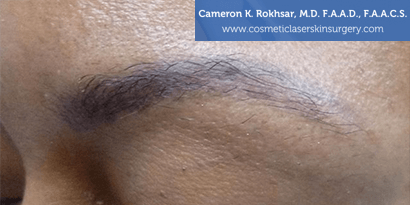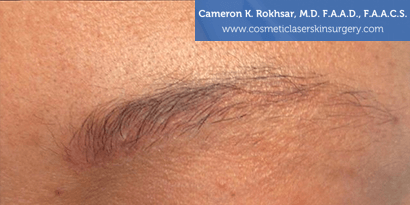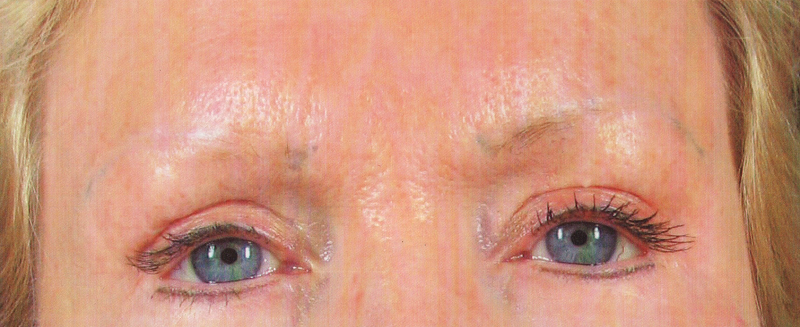Permanent makeup removal in New York
In recent times, permanent makeup has become very popular for many people who want to highlight the appearance of their eyebrows. Others use permanent eyeliner to enhance the appearance of their eyes. Permanent makeup placement is very similar to tattoo placement where a makeup artist places ink or pigment with the help of needles in the desired area of the eyebrows, lips, or eyelids, where regular makeup or eyeliner would be placed. Women find this to be an attractive option because it eliminates the need to put on daily makeup.
There are times when permanent makeup placement goes wrong. Other times, people may simply have a change of heart about the color or placement of their permanent makeup. Fortunately, there is a solution for people who want to remove their permanent makeup.
Dr. Cameron Rokhsar is a double board-certified dermatologist and dermatologic surgeon with specific fellowship training in laser surgery. Permanent makeup can be removed safely and effectively utilizing our advanced pigment lasers at the New York Cosmetic Skin & Laser Surgery Center with office locations in Manhattan New York, and Garden City, Long Island. We offer Q-Switched laser permanent makeup removal in both offices.
Laser permanent makeup removal
The process of permanent makeup removal involves using a nano-second or pico-second pigment laser to break up the ink or pigment of the permanent makeup placed in the skin into smaller pigment particles so that the body’s scavenging cells called macrophages can pig up the pigment and discard the. The process of laser permanent makeup removal is very similar to the process of tattoo removal. We use the same types of lasers for permanent makeup removal and tattoo removal for our patients in our NYC and LI offices. Microblading gone wrong can also be removed through the same process as laser permanent makeup removal.
The area of the permanent makeup is first numbed with numbing injections. Once the numbing injections are administered the process is completely painless. The laser is then used to treat the areas of the permanent makeup. The permanent makeup areas become white and frosty looking first. They then turn slightly red and inflamed. It typically takes a few days to one to two weeks for the areas to completely heal. The laser-treated areas of the permanent makeup should be washed daily with soap and water. A generous amount of ointment like Vaseline or Aquaphor should be applied to the laser-treated area two or three times a day to keep the area moist. This expedites the healing process.
The number of laser sessions needed to remove permanent makeup depends on how dark the permanent makeup is and how deep the ink of the permanent makeup was placed in the skin by the permanent makeup artist. The darker and deeper the color of the permanent make up the more laser sessions may be required. Faded old permanent makeup will resolve faster than newly placed tattooed makeup. It can take one to 6 laser sessions to completely remove permanent makeup. Faded permanent makeup can be removed with as few as one session. The average number of laser sessions for permanent makeup removal may be 2 or 3. The sessions for laser permanent makeup removal can be spaced 4-6 weeks apart. You need to see a board-certified laser dermatologist who is experienced in removing permanent makeup with lasers. Permanent makeup removal with Q-Switched laser is a safe and effective procedure in the hands of an experienced dermatologist like Dr. Rokhsar.
Permanent makeup removal results


* Results May Vary
Eyebrow permanent makeup removal
Eyebrow and eyelid permanent makeup removal is done routinely in the NYC and LI Offices of Dr. Cameron Rokhsar, a double board-certified laser dermatologist and surgeon. Dr. Rokhsar has years of experience in laser surgery as a fellowship-trained dermatologist. Both undesired permanent makeup and poorly done microblading of the eyebrows can be successfully removed with lasers. It is important to know that white or yellow colors can not be removed. But most other colors including black, brown, blue, and green colors can be removed with ease with our advanced lasers. Dr. Rokhsar also has particular experience removing poorly placed eyeliner makeup, or permanent makeup that has bled into other areas of the surrounding eyelid skin. The eyelid is a tricky area because you have to make sure your laser places a shield inside your eye to protect your eye from the laser. Many doctors do not know the technique to place shields inside the eye. You have to make sure that you see a doctor who knows how to put a shield inside your eye for safety of your eyes. Dr. Rokhsar uses stainless steel intracorneal shields to protect the eye. Dr. Rokhsar first numbs the eye with a numbing drop before inserting the eyeshield. The patient actually does not feel the eyeshield being inserted. Dr. Rokhsar then numbs the areas of the eyelid or eyebrow tattoo with lidocaine injections. The procedure after this point is completely painless. Dr. Rokhsar has treated hundreds of patients successfully with lasers to remove their permanent eyelid and eyebrow tattoos.
Reasons for permanent makeup removal
There are many reasons people may want to remove their permanent makeup. The primary reason is if the makeup artist poorly places the eyeliner or eyebrow makeup and applies it to areas outside of the cosmetic unit it was supposed to be placed on. This is a common problem with the application of permanent eyelid makeup because this is a highly skilled and tricky procedure. Sometimes the permanent makeup just does not look right as time goes on. The permanent may look faded, change colors over time or become discolored. Some people may be that their permanent makeup is out of touch with current fashion and beauty trends or has become outdated or old-fashioned. Regardless of the reason, Dr. Rokhsar offers a viable solution to get rid of your unwanted permanent makeup through removal with lasers.
Permanent makeup removal FAQ
What is permanent makeup?
Permanent makeup, also known as permanent cosmetics, derma-pigmentation, micro-pigmentation, and cosmetic tattooing, is a cosmetic technique that employs tattoos as a means of producing designs that resemble makeup. The procedure involves using a needle to place pigmented granules beneath the upper layers of the skin, similar to a tattoo. This technique is typically used to enhance the appearance of eyebrows, eyeliner, and lip color. The pigment is placed deep in the skin, making it permanent.
Unlike traditional, permanent makeup is semi-permanent and can last from two to ten years depending on the procedure. It requires a 7-10 day healing process, during which the treated area should be kept dry and cool, away from sun exposure, sweating, and water.
Permanent makeup is essentially a form of tattooing and requires the use of sophisticated tools and machines as well as pigments. The procedure is typically performed by a technician who applies the pigment with a needle. The pigment is available in a range of colors and can be customized to the client’s preferences.
Permanent makeup is a cosmetic technique that mimics the look of traditional makeup and involves the use of tattoos to enhance the appearance of the face, lips, and eyelids. It is a semi-permanent procedure that can last from two to ten years and requires a 7-10 day healing process. The pigment is placed deep in the skin and is available in a range of colors, which can be customized to the client’s preferences.
What is semi-permanent makeup?
Semi-permanent makeup, also known as semi-permanent cosmetics or SPMU, is a cosmetic technique that involves applying pigment to the skin to enhance or replicate the appearance of makeup. The effects of the makeup typically last for a couple of years, depending on the procedure, and are considered semi-permanent. The most common treatments include eyeliner, eyebrows, lip colors, and 3D areola, and the technique can be used to enhance other areas of the face as well.
Unlike traditional makeup that needs to be reapplied regularly, semi-permanent makeup stays on your face at all times, including when you exercise, swim, sleep, shower, eat, or cry. This can save time and effort for those who wish to maintain a consistent look without the need for daily application. The pigments used in semi-permanent makeup are inserted into the dermal layer of the skin using micro-needles and are typically hypoallergenic.
Semi-permanent makeup is considered safe when done by a trained professional. The techniques, tools, and inks used have improved drastically over time, offering more natural-looking results and limiting the need for touch-ups to approximately once a year.
How does permanent makeup work?
Permanent makeup, also known as cosmetic tattooing or micro-pigmentation, is a process where pigment is implanted into the skin to create the appearance of makeup that won’t wash off. The procedure is similar to tattooing and uses a hollow needle that releases color into a hole in the skin. The United States regulates the inks and conditions under which they are applied just like with a tattoo salon.
Permanent makeup can be used to create the look of everyday cosmetics, such as eyebrow pencils, eyeliner, or lip color. The process involves using machines or manual tools specially designed for the treatment being performed, such as microblading, which is done with a manual blade that consists of tiny needles that deposit pigment under the skin, or using pens or state-of-the-art machines for tattooing.
The procedure may still sting, just like it does when getting a tattoo, although the pigment is applied to the top layer of skin only. The process can mimic eyeliner or lipstick, or it can darken and create the look of thicker eyebrows. Techniques for creating permanent eyebrows include drawing numerous individual strokes between the hairs or using a dotting effect, such as powder brows.
It takes about three weeks for the pigment to fade to the color you selected, and permanent makeup lasts about one to five years on the skin. While the procedure is similar to a tattoo, it embeds iron oxide into the skin, so it looks like permanent makeup. Overall, permanent makeup is a great option for individuals who want to save time applying makeup or for those who have lost hair due to medical conditions or aging.
How long does permanent makeup last?
The duration of the permanence of the makeup varies depending on the individual’s skin type, the technique used, and the pigment applied.
The typical duration of permanent makeup on the skin is between one to five years, with touch-ups required as the color fades gradually over time. Some people may retain pigment more effectively than others, and some colors may last up to ten years.
The longevity of specific permanent makeup applications varies, with different techniques and areas of the face lasting different lengths of time. Permanent lipstick can last 2-3 years with regular touch-ups, while permanent eyeliner is indeed permanent, but touch-ups are usually required every two to five years. Eyebrow pigmentation can last 1-2 years, while scalp micropigmentation can last up to 10 years.
The healing process for permanent makeup can take several days to two weeks, with the initial color appearing darker and then gradually lightening as it heals. The procedure itself can take two to three hours, with a follow-up visit scheduled about a month later to check the healing process, evaluate results, and apply touch-ups as needed.
How to remove permanent makeup?
If you are unhappy with the results of your PMU or simply want to remove it, there are several methods you can try. Here are some options:
- Laser removal: This is one of the most popular methods of PMU removal. It involves using a pigment-specific laser to break up the ink particles in the skin, which are then absorbed by the body’s immune system over time. Laser removal can take several sessions, and there will be periods of skin recovery between them.
- Saline removal: This method involves injecting a saline solution into the skin above the unwanted pigments. The solution dries up the pigments, which are then removed as the skin heals and forms a scab. Saline removal can take several sessions, and there will be periods of skin recovery between them.
- Professional removal services: Some PMU artists or cosmetic clinics offer PMU removal services using one of the methods mentioned above. These services can be costly, and the success and number of treatments required will depend on the ink used and other factors.
Regardless of which method you choose, it’s important to follow aftercare guidelines, such as avoiding sun exposure, keeping the area clean and dry, and avoiding vigorous exercise for the first 24 hours. Always consult with a professional before attempting to remove PMU on your own.
How to lighten permanent makeup?
Permanent makeup can be lightened through various methods, including the use of bleaching agents, laser treatments, dermabrasion, chemical peels, and sun exposure. Bleaching agents, such as hydrogen peroxide, can be applied to the area of the skin with permanent makeup to lighten the pigment. However, this method is not always effective and may require multiple treatments to see results. Laser treatments, dermabrasion, and chemical peels can also be used to lighten permanent makeup, but the best method for an individual will depend on various factors, including the type and depth of the pigment, skin type, and budget.
Sun exposure is another option to lighten permanent makeup, but it is important to use sunscreen to protect the skin. It should be noted that this method is not the quickest way to see results and may require several sessions in the sun. Additionally, over-the-counter lightening creams can be used to fade semi-permanent makeup, but it is important to test the cream on a small area of skin first to avoid any adverse reactions.
What laser is used to remove permanent makeup?
The Q-Switched laser is the most commonly used type of laser for this purpose Dr. Rokhsar. Other types of lasers that can be used include Pico such as Picosure or Picoway.
During the permanent makeup removal process, laser energy is delivered to the tattoo using ultra-short nanoseconds or picosecond pulses, which break down the pigment without harming the surrounding skin. The laser energy is absorbed by the ink, which is then broken up into smaller pieces. This allows the body’s immune system to absorb it and clear it out of the body.
Permanent makeup removal typically requires multiple treatment sessions and different lasers may be necessary to treat various makeup shades. Some colors of pigmentation are more difficult to remove than others, and if the color is closer to black, the chance for success is greater.
New York Office Locations
Upper East Side Manhattan Office
121 East 60th Street, Suite 8AB New York, NY 10022
(212) 285-1110
Long Island Office
901 Stewart Ave, Suite 240, Garden City, NY 11530
(516) 512-7616



 Dr. Rokhsar was chosen by
Dr. Rokhsar was chosen by 






